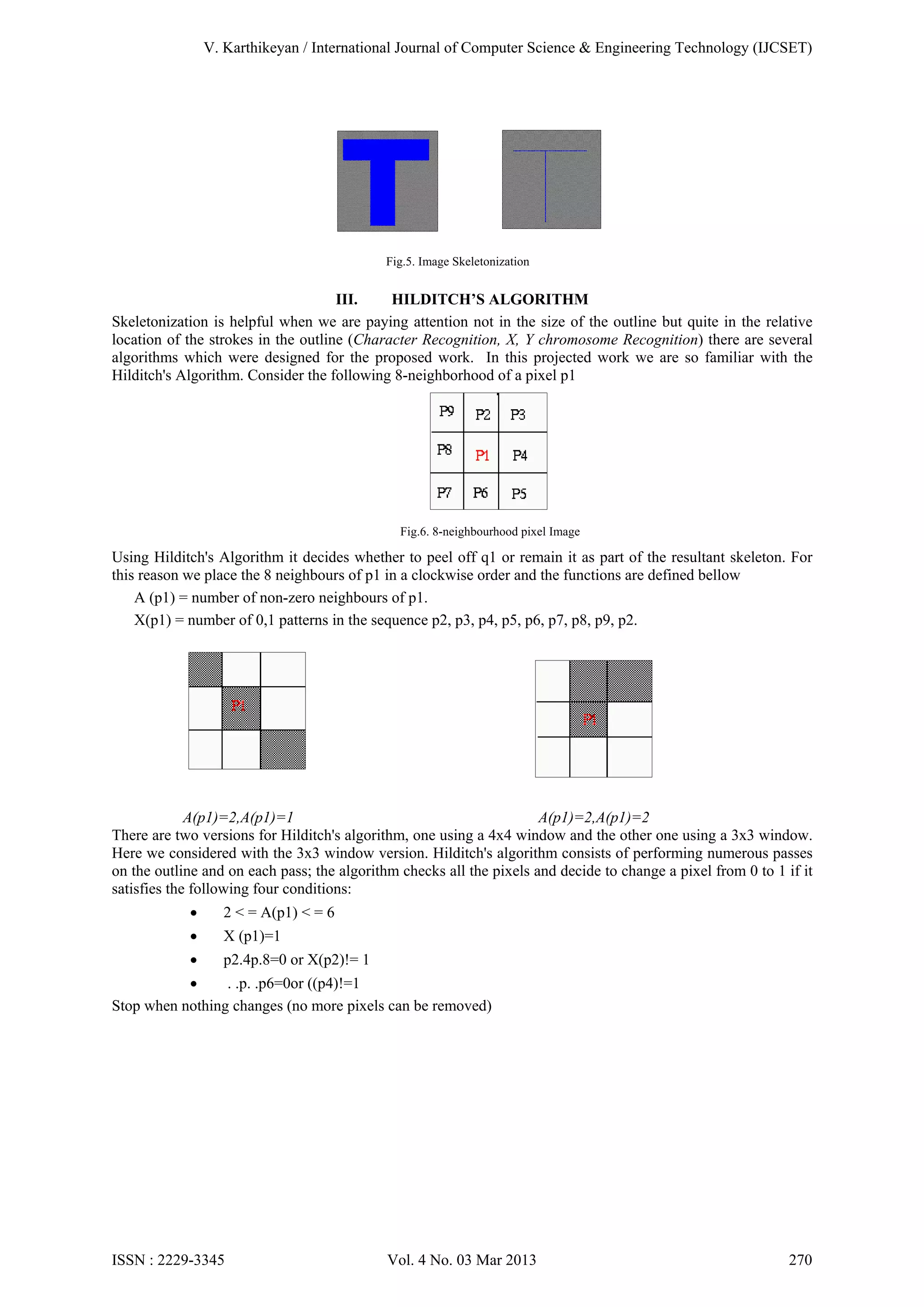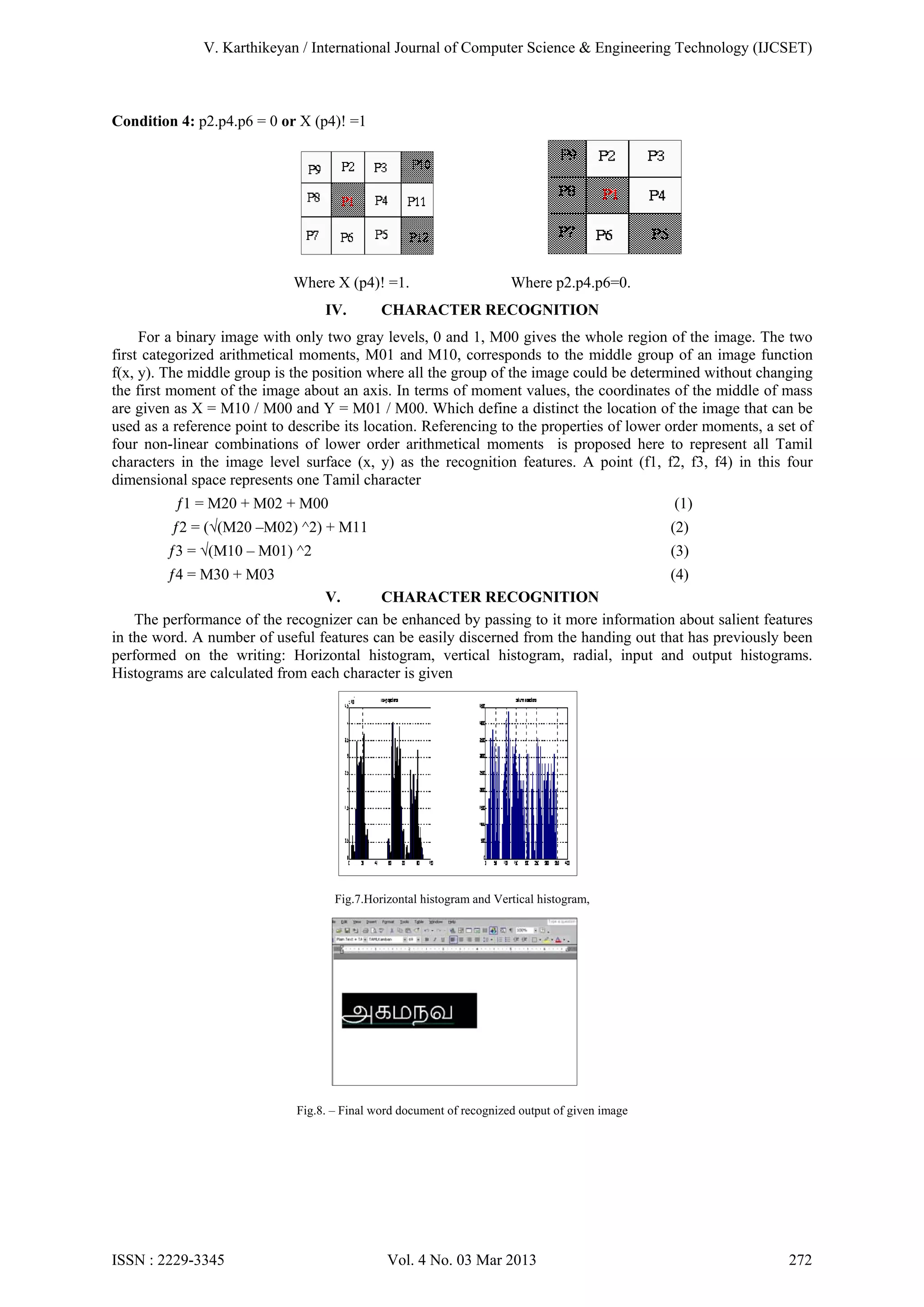1) The document presents a Tamil character recognition system using Hilditch's algorithm and structural characteristics of characters.
2) It describes the image preprocessing steps of binarization, segmentation, bounding box detection, normalization and skeletonization.
3) Hilditch's algorithm is applied to obtain thin, connected skeletons of characters.
4) Moments-based features are extracted from skeletons for character recognition using a neural network classifier.
5) The system achieved a recognition accuracy of 99% for identified Tamil characters.

![V. Karthikeyan / International Journal of Computer Science & Engineering Technology (IJCSET)
line. They match to the least value and greatest zero value positions neighboring a text line, respectively. (See
Fig. 1) We extract two more reference lines from each text line, namely, the upper baseline and the lower
baseline. For this, we use a method similar to [1]. First derivative of the horizontal projection profile is
calculated for each segmented text line. The restricted intense of the first imitative in the two halves of the text
line are taken to be the two baselines. The lines drawn across the two peaks indicate the two baselines. Words
and characters are segmented using the perpendicular projection outline of each text line. Word borders and
character borders are noticeable as the previous are much wider than the final. The algorithm is based on a
particular attention to straightening out hand-printed characters which was “stirring” due to reduced scanner
resolution. The program initially looked for characters, which were not stirring (separated by columns of zeros).
Fig.2. Line segmentation using horizontal and vertical projection outline
C. Bounding Box
Before examining the characters, it is significant to recognize the (pixel) boundaries of the particular character.
Therefore, a bounding box has to be recognized for every character. For this, we primarily compute the rowwise parallel projection of the complete text file and classify begin and finish positions of every line, from the
valleys in the projection. Having found the line pixels, we find the perpendicular projection of each line, the
valleys of which show the boundaries of every character in the line [2]. While, each of the characters in a line
might not be of identical height, so we consider only an estimated bounding rectangle for the characters. This is
a critical stage in instant based identification methods and can be intended from a perpendicular projection of
the bounding box.
Fig.3. Bounding of each character
D. Normalization
After analyzing each character, it is significant to identify the boundaries of individual character. Thus, a
bounding box is identified for each character. Similarly, each one of the character in a line might not be in the
same height, what we have now processed is only an approximate bounding box for the characters. So we must
make the each character at same height we go for Normalization. It is the process of giving accurate size and
equal height to each character in the identified image.
Fig.4. Normalized character Image
E. Skeletonization
Skeletonization is the method of detaching off of an outline as a lot of pixels as possible as lack of disturbing the
common form of the outline. In other words, subsequent to pixels have been detached off, the outline should still
be recognized. Hence we use the method for detaching the outline by the Skeletonization process is used to
obtain as thin as possible, connected and centered when these are satisfied, then the algorithm must stop.
ISSN : 2229-3345
Vol. 4 No. 03 Mar 2013
269](https://image.slidesharecdn.com/v-131124010559-phpapp02/75/V-karthikeyan-published-article-2-2048.jpg)



![V. Karthikeyan / International Journal of Computer Science & Engineering Technology (IJCSET)
VI.
CONCLUSION
From these image processing algorithms and predefined pattern helps to recognize the Tamil characters. So
we concluded that these kind of image processing plays important role in both theoretical and practical way of
doing. We are trying to identify all the Tamil characters through the complex image processing algorithms and
increasing the recognition patterns of the character.
REFERENCES
[1]
R. M. Bozinovic and S. N. Srihari, “Off-line cursive script word recognition”, IEEE Trans. On Pattern Anal. Mach. Intell., vol. 11, no.
1, pp. 68-83, Jan. 1989.
[2] H. Bunke, P.S.P. Wang, "Handbook of Character Recognition and Document Image Analysis", World Scientific, 1997.
[3] Abhijit, S. P. and Macy, R. B., Pattern Recognition With Neural Networks in C++, CRC Press, 1995
[4] E.Kavallieratou N.Fakotakis G.Kokkinakis “Handwritten characteristics based on the structural characteristics”, In proc.
ICPR.2000.,pp 634
[5] Jagadeesh Kannan R and Prabhakar R, ”An improved Handwritten Tamil Character Recognition
[6] System using Octal Graph”, Int. J. of Computer Science, ISSN 1549-3636, Vol 4 (7): 509-516, 2008
[7] Jagadeesh Kumar R, Prabhakar R and Suresh R.M, “Off-line Cursive Handwritten Tamil Characters Recognition”, International
Conference on Security Technology, page(s): 159 – 164, 2008
[8] Paulpandian T and Ganapathy V, “Translation and scale Invariant Recognition of Handwritten Tamil characters using Hierarchical
Neural Networks”, Circuits and Systems, IEEE Int. Sym. , vol.4, 2439 –2441, 1993
[9] Ramanathan R, Ponmathavan S, Thaneshwaran L, Arun.S.Nair, and Valliappan N, “Tamil font Recognition Using Gabor and Support
vector machines”, International Conference on Advances in Computing, Control, & Telecommunication Technologies, page(s): 613 –
615, 2009
[10] Sarveswaran K and Ratnaweera , “An Adaptive Technique for Handwritten Tamil Character Recognition”, International Conference
on Intelligent and Advanced Systems, page(s): 151 – 156, 2007
ISSN : 2229-3345
Vol. 4 No. 03 Mar 2013
273](https://image.slidesharecdn.com/v-131124010559-phpapp02/75/V-karthikeyan-published-article-6-2048.jpg)